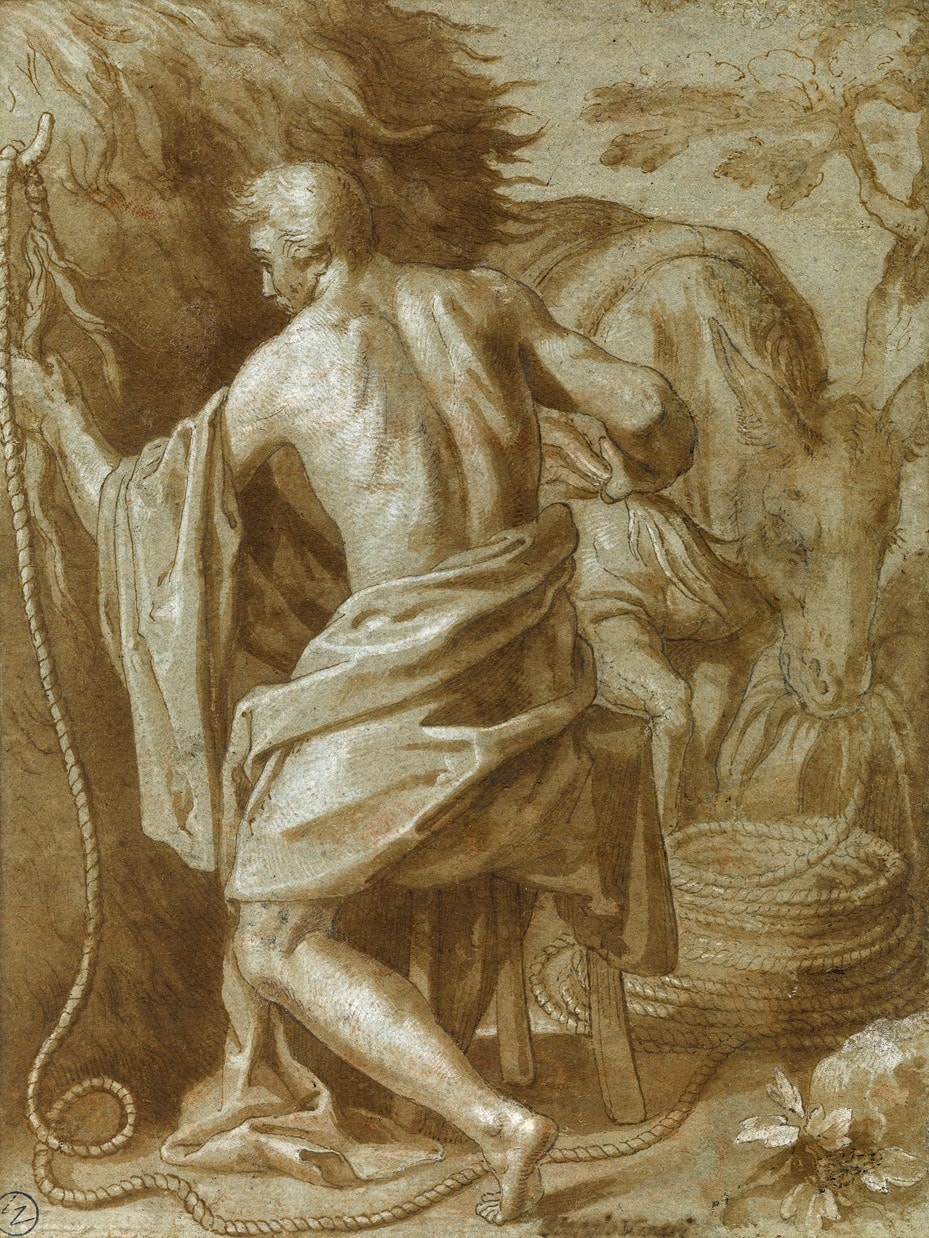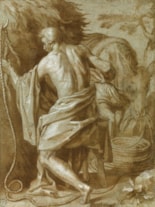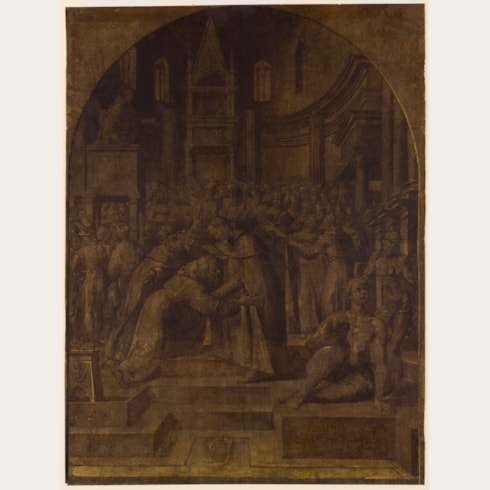Jacopo LIGOZZI
(Verona c.1549 - Florence 1632)
Ocnus: An Allegory of the Futility of Labour
Sold
Pen and brown ink and wash, heightened with white, over an underdrawing in black chalk, on blue paper.
The outlines of the main figure indented for transfer and the verso washed red.
Inscribed Giorgio Vasari [cancelled] at the lower right.
200 x 151 mm. (7 7/8 x 6 in.)
The outlines of the main figure indented for transfer and the verso washed red.
Inscribed Giorgio Vasari [cancelled] at the lower right.
200 x 151 mm. (7 7/8 x 6 in.)
In its use of blue paper and its stylistic relationship with late 16th century Veronese and Venetian draughtsmanship, the present sheet may tentatively be dated to the early part of Jacopo Ligozzi’s career, while he was working in Verona or shortly after his arrival in Florence in 1577. Jennifer Montagu has pointed out that the unusual subject of this drawing derives from an ancient Greek painting by Polygnotus of the mythological character of Ocnus (or Oknos); a figure symbolic of futility, or unending labour. Ocnus was condemned to spend eternity weaving a rope of straw which, in turn, was eaten by a donkey almost as fast as it is made. As Montagu notes, Ocnus ‘had an extravagant wife who spent everything he earned by his labours; he is represented as a man twisting a cord, which an ass standing by eats as soon as he makes it, whence the proverb ‘the cord of Ocnus’ often applied to a labour which meets no return, and is totally lost.’ This unusual subject is extremely rare in 16th or 17th century Italian art.
Many of Ligozzi’s highly finished drawings were executed as independent works of art, and this may be true of the present sheet. However, the partially incised contours of the figure, and the red wash applied to the verso of the sheet, would suggest that the drawing may have been preparatory to a print, possibly a chiaroscuro woodcut. A handful of allegorical drawings by Ligozzi were in fact reproduced as chiaroscuro woodcuts in c.1585 by the Mantuan engraver Andrea Andreani (c.1546-1623), and the artist’s technique, with its emphasis on strong lines and tonal contrasts, lent itself well to the particular demands of the chiaroscuro medium.
Ligozzi’s reputation as a designer of innovative allegorical compositions was well established early in his career and, as one scholar has recently noted, he ‘produced (and was most probably the originator of) ingenious allegorical compositions…The content of Ligozzi’s drawings is often very unusual and their sources are extremely unexpected.’ Similar allegorical subjects occur in other finished drawings by Ligozzi, such as an Allegory of Envy and an Allegory of Vanity in the Kestner Museum in Hannover, both signed and dated 1590, as well as an Allegory of Avarice in the National Gallery of Art in Washington, D.C. and an Allegory of Charity, Justice and Strength in the collection of the Bibliothèque Nationale in Paris.
Many of Ligozzi’s highly finished drawings were executed as independent works of art, and this may be true of the present sheet. However, the partially incised contours of the figure, and the red wash applied to the verso of the sheet, would suggest that the drawing may have been preparatory to a print, possibly a chiaroscuro woodcut. A handful of allegorical drawings by Ligozzi were in fact reproduced as chiaroscuro woodcuts in c.1585 by the Mantuan engraver Andrea Andreani (c.1546-1623), and the artist’s technique, with its emphasis on strong lines and tonal contrasts, lent itself well to the particular demands of the chiaroscuro medium.
Ligozzi’s reputation as a designer of innovative allegorical compositions was well established early in his career and, as one scholar has recently noted, he ‘produced (and was most probably the originator of) ingenious allegorical compositions…The content of Ligozzi’s drawings is often very unusual and their sources are extremely unexpected.’ Similar allegorical subjects occur in other finished drawings by Ligozzi, such as an Allegory of Envy and an Allegory of Vanity in the Kestner Museum in Hannover, both signed and dated 1590, as well as an Allegory of Avarice in the National Gallery of Art in Washington, D.C. and an Allegory of Charity, Justice and Strength in the collection of the Bibliothèque Nationale in Paris.
Born into a family of painters and decorators in Verona, Jacopo Ligozzi spent almost the entirety of his long career in Florence, where he arrived in 1575, summoned by the Grand Duke Francesco I de’ Medici. Trained as a miniaturist (it is interesting to note that even in his large paintings he often signed his name as ‘Jacopo Ligozzi miniator’), he was admitted into the Florentine Accademia del Disegno in 1582. Ligozzi worked as court artist for four successive Medici Grand Dukes, from Francesco I to Ferdinando II, executing numerous designs for tapestries, furniture, glass, jewellery, pietra dura and metalwork. According to Medici inventories, however, much of his work took the form of small-scale paintings, often of a devotional or emblematic nature.
Ligozzi’s first important public commissions came in the 1590’s, notably two monumental historical scenes, painted on slate, for the Salone dei Cinquecento of the Palazzo Vecchio, completed in 1592. He painted altarpieces for such local churches as Santa Maria Novella, San Marco and San Giovannino degli Scolopi. He also painted altarpieces for churches elsewhere in Tuscany; in Bibbiena, Poppi, Arezzo and at Monte Oliveto Maggiore, and returned briefly to his native Verona around 1591. Ligozzi’s best-known works as a painter are, however, a series of seventeen lunette frescoes of scenes from the life of Saint Francis for the church of Ognissanti in Florence, completed in 1600. The artist became increasingly devout as he grew older, and among his late altarpieces is a Martyrdom of Saint Lawrence for the Florentine church of Santa Croce, painted in 1611. His last Medici commission was for a series of four paintings of the Passion of Christ, painted between 1621 and 1622 for Maria Maddalena of Austria, mother of the young Grand Duke Ferdinando II and co-regent during his minority.
Ligozzi was a superbly gifted draughtsman, and was esteemed as such by his contemporaries. As one modern scholar has noted, ‘The most authentic, coherent vein of Jacopo’s work is expressed in his graphic output: he was a born draughtsman, a draughtsman of immense precision, of drawings so meticulous as to occasionally become for the artist and his commissioners works of art for their own sake, and sought after as such.’ It is interesting to note that, when Ligozzi was engaged as a court artist by the Medici Granducal court in the early 1620’s, the terms of his employment were tied to his output as a draughtsman. As the document noted, ‘If there is no occasion to employ him, have him do drawings to keep him in the gallery…just have him draw, leave it up to him, whatever he does he will produce sheets worth keeping, and for that very reason we want him at court.’
Ligozzi’s drawings exhibited a wide range of subject matter that included religious scenes, allegories, designs for glassware and costume studies, as well as literary subjects, notably a series of episodes from Dante’s Divina Commedia, drawn between 1587 and 1588. In keeping with Grand Duke Francesco I’s interest in natural history, Ligozzi also produced a large number of scientific drawings depicting specimens of fishes, birds and flowers in the Granducal collections. An album of such drawings is recorded in the Medici Guaradroba in 1619, and a large number of natural history drawings by Ligozzi are today in the Uffizi; some of these were also used to illustrate the treatises of the Bolognese naturalist Ulisse Aldovrandi. Ligozzi also provided a number of designs for printmakers such as Agostino Carracci, Philippe Thomassin and the chiaroscuro woodcutter Andrea Andreani. Whatever the subject, Ligozzi’s drawings are invariably highly finished, often heightened with touches of gold, and combine a meticulous technique with a miniaturist’s attention to detail.
Provenance
Marie-Guillaume-Thérèse de Villenave, Paris (Lugt 2598)
Possibly his posthumous sale, Paris, 84 rue de Vaugirard, 1-5 February 1847
Louis Valentin, Paris (Lugt 2498), his mark on the old mount
Francesco Dubini, Milan
Ulrico Hoëpli, Milan
Anonymous sale, Milan, Finarte, 21-22 April 1975, lot 43
Margot Gordon, New York, in 1987
P. & D. Colnaghi, London, in 1992
Private collection, Connecticut, until 2007.
Exhibition
New York, Margot Gordon, Italian Drawings of XVI Century, 1987, no.25; New York and London, P. & D. Colnaghi, Master Drawings, 1992, no.17.





